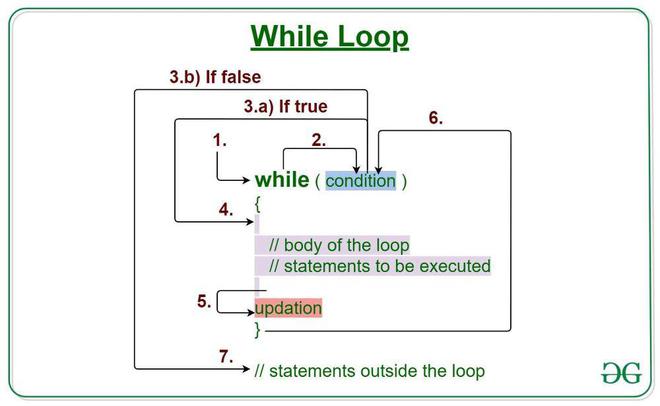Java while Loop

Java while loop is a control flow statement used to execute the block of statements repeatedly until the given condition evaluates to false. Once the condition becomes false, the line immediately after the loop in the program is executed.
Let's go through a simple example of a Java while loop:
public class WhileLoop {
public static void main(String[] args) {
// Initialize the counter variable
int c = 1;
// While loop to print numbers from 1 to 5
while (c <= 5) {
System.out.println(c);
// Increment the counter
c++;
}
}
}
public class WhileLoop { public static void main(String[] args) { // Initialize the counter variable int c = 1; // While loop to print numbers from 1 to 5 while (c <= 5) { System.out.println(c); // Increment the counter c++; } }}Output
1 2 3 4 5
Explanation: In this example, it prints the numbers from 1 to 5 by repeatedly executing the loop as long as the counter variable "c" is less than or equal to 5.
Table of Content
Syntax of while loop in Java
while (test_expression) {
// statements
update_expression;
}
Note: If we do not provide the curly braces ‘{‘ and ‘}’ after while( condition ), then by default while statement will consider the immediate one statement to be inside its block.
Parts of Java While Loop
- Test Expression: This condition is evaluated before each iteration. If it returns true, then the loop executes; otherwise, the loop exits. For Example: i<=5
- Update Expression: After executing the loop body, this expression increments/decrements the loop variable by some value. For Example: i++
Execution of While Loop in Java
Now, let's understand the execution flow of while loop with the below diagram:

- Control enters the while loop.
- The condition is tested.
- If true, execute the body of the loop.
- If false, exit the loop.
- After executing the body, update the loop variable.
- Repeat from step-2 until the condition is false.
Examples of Java while loop
Below are the examples of Java while loop that demonstrates repeating actions and performing calculations.
Repeating a Message with while loop
The below example demonstrates how to use while loop to execute code specified number of times.
// Java program to illustrate while loop
class whileLoop {
public static void main(String args[])
{
int i = 1;
// test expression
while (i < 6) {
System.out.println("Hello World");
// update expression
i++;
}
}
}
// Java program to illustrate while loopclass whileLoop { public static void main(String args[]) { int i = 1; // test expression while (i < 6) { System.out.println("Hello World"); // update expression i++; } }}Output
Hello World Hello World Hello World Hello World Hello World
Explanation: In the above example, the while loop runs until "i" is less than 6 and prints "Hello World" 5 times.
Calculating the Sum of Numbers from 1 to 10 with Java while Loop
This example demonstrates how a while loop can be used to calculate a result through repeated addition.
// Java program to illustrate while loop
class whileLoop {
public static void main(String args[])
{
int i = 1, s = 0;
// loop continues until i becomes greater than 10
while (i <= 10) {
// add the current value of i to s
s = s + i;
// increment i for the next iteration
i++;
}
System.out.println("Summation: " + s);
}
}
// Java program to illustrate while loopclass whileLoop { public static void main(String args[]) { int i = 1, s = 0; // loop continues until i becomes greater than 10 while (i <= 10) { // add the current value of i to s s = s + i; // increment i for the next iteration i++; } System.out.println("Summation: " + s); }}Output
Summation: 55
Explanation: This program finds the summation of numbers from 1 to 10.


While Loop
